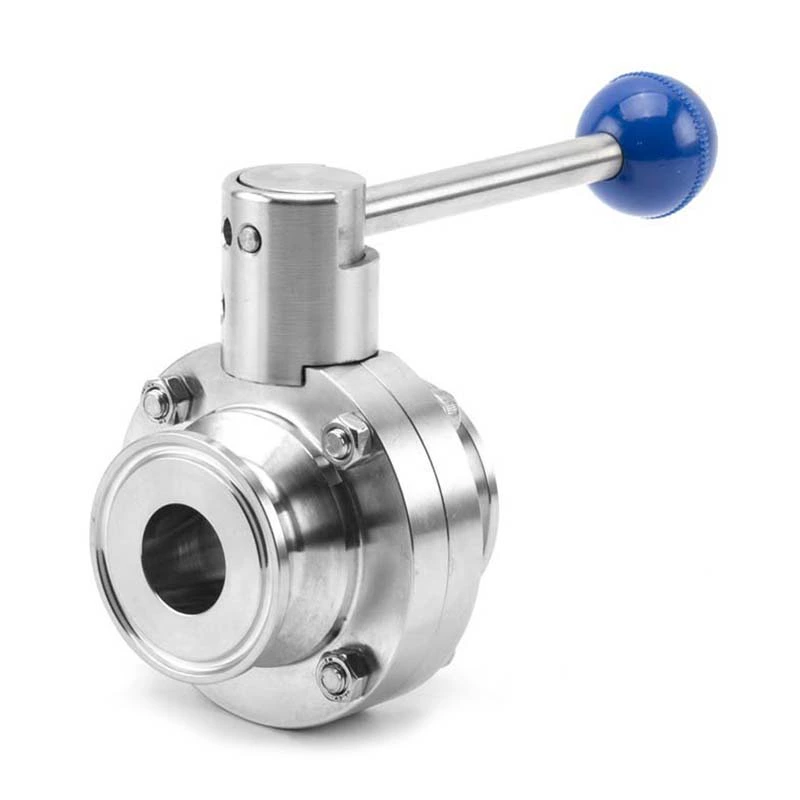Problems And Requirements In Manufacturing Stainless Steel Sanitary Butterfly Valves
Sanitary Butterfly Valve Due to the lower design, manufacturing and production capacity than the advanced foreign level, coupled with the limitation of automation control level, there has been no breakthrough in the important sanitary butterfly valve technology, and there are many problems.
One of the most important problems of stainless steel sanitary butterfly valves, and the easiest to solve, is the cleanliness of stainless steel sanitary butterfly valves. Grease is often used for lubrication during installation, but most manufacturers do not clean it after installation, resulting in dust and other foreign matter adhering to the grease surface, forming black lumps.
Grease should be compatible with sanitary ball valve metal materials, rubber parts, plastic parts and working media. When the working medium is gas, special 221 grease can be used. Apply a thin layer of grease on the surface of the seal installation groove, a thin layer of grease on the rubber seal, and a thin layer of grease on the sealing surface and friction surface of the valve stem.
During assembly, metal debris, fiber, grease (except for specified use), dust and other impurities, foreign matter, etc. should not be allowed to contaminate, adhere or stay on the surface of the parts or enter the inner cavity.
1. Low design level The design level of domestic valves is far behind that of technologically developed countries. So far, some high-tech sanitary ball valves such as main steam isolation valves, large-caliber safety valves, and earthquake-resistant control valves have not made major breakthroughs.
2. Most of the domestic stainless steel sanitary butterfly valve manufacturing equipment is based on universal machine tools, and the product manufacturing accuracy is low. In addition, its manufacturing process level is backward. For example, the vacuum electron beam welding process and shear extrusion technology used in forging and welding structures have not been widely promoted and applied. Therefore, the manufactured sanitary butterfly valves are far from meeting the operating requirements of nuclear power equipment.
3. Poor control level of drive actuators The performance and control level of the domestic sanitary butterfly valves are only equivalent to the level of foreign countries in the 1980s. Its action sensitivity is poor and the overall reliability level is backward.
4. Lagging automation control capabilities Automation control capabilities include a series of control capabilities such as signal acquisition, signal comparison, signal amplification, and signal return. Large nuclear power units above 200,000 kilowatts generally use computer automatic control. The computer level of sanitary ball valves in China lags behind that of developed countries, so the valve automation control capability of nuclear power systems is also lagging behind.
There are more than 500 nuclear power units in the world, and my country has built 6 (with a total installed capacity of 8.7 million KW). At present, my country is planning to build 4 units - two 300,000 KW units in Qinshan Phase I expansion; Qinshan Phase II Units 3 and 4; Sanmen Nuclear Power 6 million KW nuclear power units; Tianwan Nuclear Power Station 4 million KW nuclear power units. It is reported that before 2020, my country will also plan to build more than 20 nuclear power plants in Lingdong, Yangjiang and Taishan, Shenzhen, Guangdong; Chongqing Fuling; Dalian and other places.
At present, my country has begun to devote itself to the research of internationally advanced third-generation nuclear power units. The project has been included in the country's 11th Five-Year Plan since 2006, and it is expected that a commercially available prototype nuclear reactor fast reactor will be built by 2020. The third generation of pressurized water reactor nuclear power technology is very safe and can effectively prevent and alleviate serious explosion and leakage accidents like the Chernobyl nuclear power plant. At the same time, this technology shortens the construction period, replaces nuclear raw materials every 18 to 24 months, and extends the life of the unit by 60 years, greatly improving the economy.
It is understood that according to my country's energy planning, nuclear power will develop to 40 million kilowatts in 2020, accounting for 4% to 5% of the total installed capacity. Taking a nuclear power plant with a capacity of 800,000 kilowatts as an example, the demand for valves with a diameter of DN25 to 1000mm is 8,000 to 10,000 units, which is 2 to 3 times that of similar thermal power plants. According to statistical analysis, a nuclear power plant with two sets of million KW nuclear power units requires 30,000 valves of various types. Based on the construction of 2.5 million KW nuclear power units each year, the annual demand for sanitary butterfly valves is more than 38,000 units. According to the national "Eleventh Five-Year Plan" forecast, during the "Eleventh Five-Year Plan", the demand for valves in nuclear power plants will be 3 billion yuan, with an average annual demand of about 600 million yuan. In addition, since the maintenance cost of valves in nuclear power plants generally accounts for more than 50% of the total maintenance cost of nuclear power plants, the annual maintenance cost of valves in nuclear power plants is about 150 million yuan. Therefore, the market demand for sanitary butterfly valves is quite large.
